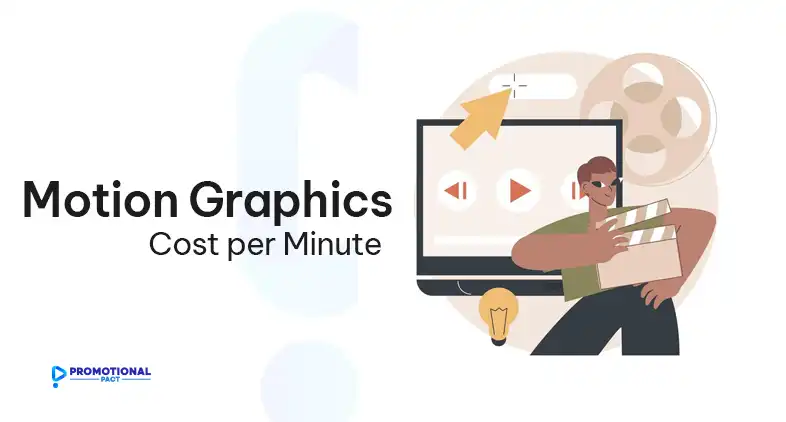Motion graphics have become an essential part of visual storytelling, playing a crucial role in marketing, advertising, education, and entertainment. They combine animation and graphic design to create engaging content that can effectively communicate complex ideas in a visually appealing way. From explainer videos to commercials, motion graphics help brands connect with their audience on a deeper level. But what does it cost to produce such content, especially when considering the cost per minute? Understanding the factors that influence this cost is key to budgeting effectively and ensuring you get the most value for your investment.

Motion Graphics Cost per Minute Depending On Various Factors
Style of Animation
The style of animation is one of the primary factors that determine the cost of motion graphics. Different styles require varying levels of expertise, time, and resources.
- 2D Animation is generally the most affordable option, with costs typically ranging from $500 to $2,000 per minute. This style involves simple shapes, flat images, and basic movements, making it suitable for explainer videos or presentations.
- 3D Animation, on the other hand, is more complex and therefore more expensive. Costs for 3D animation can range from $3,000 to $10,000 per minute. This style requires advanced software, detailed modeling, and intricate rendering processes, making it ideal for product demos, commercials, or high-end presentations.
- Stop-Motion Animation is another option, known for its unique, handcrafted feel. However, it is also the most labor-intensive and expensive, often costing $5,000 to $15,000 per minute. This style involves creating physical models and capturing each frame individually, which requires significant time and effort.
Complexity of Graphics
The complexity of the graphics is another critical factor. Motion graphics with simple shapes and basic movements are less expensive, while those with detailed character designs, complex animations, and intricate 3D models are more costly.
For example, character design can significantly increase the cost. A simple character might add $500 to $1,000 to the overall budget, while a complex character with detailed features and movements could add $2,000 to $5,000.
Similarly, the animation techniques used can double or even triple the cost. Basic motion graphics might be relatively inexpensive, but incorporating advanced techniques like particle effects, complex transitions, or 3D animations can dramatically increase the budget.
Project Scope
The scope of the project also plays a significant role in determining the cost per minute of motion graphics. The length of the video, the number of scenes, and the number of revisions all influence the final price.
A shorter project is typically less expensive on a per-minute basis, due to setup fees and the time required to create the initial elements. For instance, a one-minute explainer video might cost around $3,000, while a five-minute documentary with multiple scenes, characters, and complex storylines could cost $25,000 or more.
Each additional scene can add anywhere from $500 to $2,000 to the overall cost, depending on its complexity. Moreover, multiple rounds of revisions can increase costs by 10-20%, as they require additional time and effort from the animators.
Additional Elements
Beyond the core animation, several additional elements can increase the cost of motion graphics.
Sound design, for example, is crucial for creating a polished final product. Professional sound design can add anywhere from $300 to $1,000 per minute to the overall budget, depending on the complexity and quality of the sound effects.
Voiceover is another element that can vary in cost. Depending on the talent and language, voiceover services typically range from $200 to $1,000 per minute. A well-known voice actor or a multilingual project will generally be on the higher end of this spectrum.
Music is also an important consideration. Custom music scores can cost anywhere from $500 to $2,000, while licensed tracks might range from $50 to $500. The choice between custom and licensed music often depends on the project’s budget and the desired impact.
Production Quality
The production quality of the motion graphics significantly affects the overall cost. Higher production quality usually involves more expensive software, better equipment, and more experienced talent.
Using high-end software like Cinema 4D or Maya can increase the cost by 10-20% compared to basic software like Adobe After Effects. Similarly, hiring experienced animators and designers often results in higher costs, as they may charge $100 to $200 per hour.
The difference in production quality can be seen in the final product. A project using basic After Effects might cost $2,000 per minute, while a project involving advanced 3D modeling, detailed lighting, and realistic textures could cost $8,000 per minute or more.
Location and Studio Size
The location and size of the studio also impact the cost of motion graphics. Studios in major cities like New York, Los Angeles, or London tend to charge higher rates due to increased demand and higher operating costs. A studio in New York, for example, might charge $10,000 for a one-minute video, while a similar studio in a smaller city might offer the same service for $7,000.
Smaller studios or freelancers in less expensive regions may offer more competitive rates, but they might not have the same resources or expertise as larger studios. The choice between a large studio and a smaller one often depends on the project’s requirements and budget.
How the Cost Structure Works for Motion Graphics
Hourly Rate
Hourly rates are a common pricing model for motion graphics projects.
- Freelancers typically charge between $50 and $150 per hour, depending on their experience and location. More experienced freelancers might command rates as high as $200 to $300 per hour.
- Studios, on the other hand, usually charge higher rates, ranging from $100 to $300 per hour. Top-tier studios with extensive experience and high-end equipment might charge up to $500 per hour or more.
The hourly rate model is often used for projects with uncertain scope, where the time required can vary significantly.
Project-Based Pricing
Project-based pricing involves a fixed fee for the entire project, regardless of the time required. This model is common for well-defined projects with a clear scope and timeline.
For example, a one-minute explainer video might have a fixed price of $3,000 to $10,000, depending on the complexity and additional elements. The main advantage of this model is predictability, as clients know exactly what they will pay upfront. However, scope creep—where the project’s requirements expand beyond the original agreement—can lead to cost overruns.
Per-Minute Pricing
Per-minute pricing is another common model, where the cost is calculated based on the duration of the motion graphic. This model is particularly useful for longer projects where the length of the video is a significant factor.
- Simple Motion Graphics: Typically range from $500 to $2,000 per minute.
- Mid-Range Projects: These can cost $2,000 to $5,000 per minute, depending on the complexity and style.
- High-End Production: Complex projects with advanced elements can cost $5,000 to $15,000 per minute or more.
The per-minute model is predictable but may lack flexibility for more complex projects where the quality and intricacy of the animation are more important than the duration.
Wrapping It Up
Motion graphics are a powerful tool for visual storytelling, but they can also be a significant investment. Understanding the factors that influence the cost per minute, such as the style of animation, complexity of graphics, project scope, additional elements, production quality, and location, is essential for budgeting effectively.
To ensure the best value, it’s important to research and compare quotes, provide a detailed project brief, and negotiate where possible. Whether you’re working with a small budget or investing in a high-end production, careful planning and clear communication with your vendor can help you achieve the best results.

